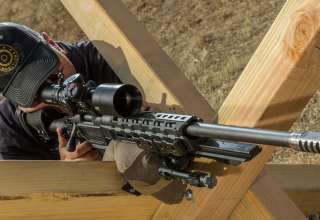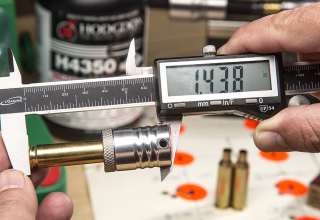For reliable, long-range accuracy out of the box and at a price point that goes down easy, Mossberg’s MVP bolt-action rifles demand attention.
by Alfredo Rico
Mossberg is known for providing quality firearms at an affordable price. What few people realize is that Mossberg is also a highly innovative company that holds patents to designs many of us use but with origins we have never considered. One such patent design is the first bolt action rifle that reliably feeds rounds from an AR-style magazine. This design is at the heart of Mossberg’s MVP series of rifles.
The MVP series is an evolution of Mossberg’s Predator line of hunting rifles. The Predator rifles were based on classic hunting rifle design and a low capacity drop box magazine. The MVP series use AR-compatible magazines. The advantages to using an AR-style magazine is that the magazines are easy to find in most gun shops, they are relatively affordable, and are available in 5-,10-, 20-, and 30-round capacities, depending on the caliber.

The MVP line includes three classic stock design models, the MVP Scout, MVP Predator, and the MVP Patrol. The use of an AR-style magazine also allowed Mossberg to stretch its design legs beyond the traditional hunting rifle. The Light Chassis Rifle (LC) and the Precision Rifle (PR) use an aluminum chassis while the Long Range rifle has a polymer stock designed for precision shooting.
Of the MVP rifles, I’ve spent the most time behind the MVP PR and the MVP LR, both of which were chambered in 6.5 Creedmoor. The rifles are also available in 7.62mm NATO and .224 Valkyrie.
Mossberg MVP Precision Rifle
With the MVP PR, Mossberg went all-out with features that will appeal to shooters seeking to get into precision rifle shooting. The PR’s aluminum chassis provides a solid, drop-in platform for Mossberg’s medium bull barrel. The chassis incorporates several AR features, including an AR-compatible stock, a replaceable pistol grip, a side magazine release button, and, of course, an AR-compatible magazine.
The Luth AR MBA3 stock is fully adjustable so a shooter can center their eye to the reticle and get comfortable behind the rifle. The cheekpiece adjusts not only in height but fore and aft, too. The length-of-pull has 4 inches of adjustment and the butt pad offers horizontal, vertical, and lateral adjustments.
Mossberg didn’t skimp on the grip, either. It’s a Magpul MOE+ pistol grip with rubber overmolding for a grippy grip in wet or cold conditions. The magazine release button will be familiar to AR users, too. The only non-AR feature is the two-position rocker safety located behind the bolt.


One of Mossberg’s most underrated components is its adjustable Lightning Bolt Action trigger (LBA). The trigger can be found on a wide array of their bolt action rifles, and it is adjustable from three to seven pounds. I’ve shot many Mossberg rifles with this trigger and have often found it to be lighter and crisper than many production rifle triggers in its class.

When I handloaded Hornady’s 120 ELD-M bullets and performed a ladder test, the rifle continued to impress me. I perform my ladder tests at 300 yards and shot 3-shot groups for 10 incremental loads. The average group for all 30 shots was a .50 MOA. That would be impressive even for a custom rifle let alone a production rifle with a street price hovering around $900.
Mossberg MVP Long Range Rifle
If your budget for a long-distance rifle is a little smaller, don’t overlook Mossberg’s MVP Long Range rifle. With a street price of around $670, it offers a lot of value for the buck. More importantly, once you find the ammo it shoots best, it’s an excellent entry platform to long-range shooting.
The MVP Long Range rifle shares many features of the MVP Precision Rifle, such as a two-position trigger, AR-compatible magazine, fluted bolt, LBA trigger, and oversized bolt handle. The medium-bull barrel is 20-inches and fluted.
Where the MVP Long Range differs greatly from the MVP Precision Rifle is the comparatively minimalist stock. The polymer synthetic stock is pillar bedded and has features you would expect on a precision rifle—an adjustable cheek piece (a Mossberg patent), a vertical grip, and a wide forearm. Additionally, the bottom of the stock is scooped to allow room for your hand when using a rear bag. The barrel is 20-inches with a medium contour.
My first experience with the MVP Long Range rifle was at Gunsite Academy, where a friend and I were testing firearms. My friend had sighted in the Long Range rifle at 100 yards and was shooting groups to test the rifle’s accuracy. After shooting three groups, he was disappointed at the 1.5-inch – 2-inch five-shot groups he was getting. I looked down range through my scope and agreed—the groups were large for that rifle.
I initially thought the rifle may like a different weight bullet or needed 50-100 rounds to break in the barrel. Breaking in a barrel is common on rifles—to what extent varies among barrels and manufacturers.

The MVP series of rifles are an impressive bunch, especially the MVP PR and MVP LR. They show that Mossberg focuses on the important details that make for a great shooting rifle. They have plenty of accuracy to confidentially shoot long distances and the patented bolt head design works flawlessly. Like any rifle, they’re not perfect. But for the price point and performance, they are an excellent choice for long distance shooting.
- Precision Rifle Shooter Must-Haves - June 6, 2022
- Reloading for Precision Rifles - March 10, 2022
- Field Test: Mossberg’s MVP Rifles - March 2, 2020















